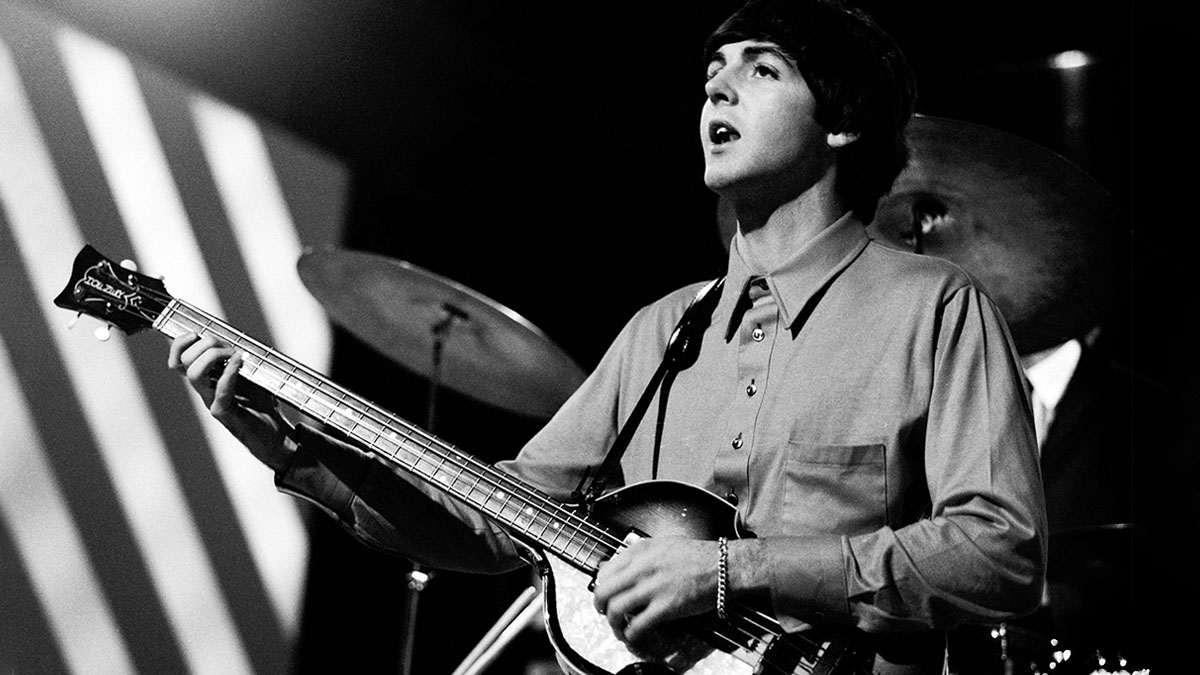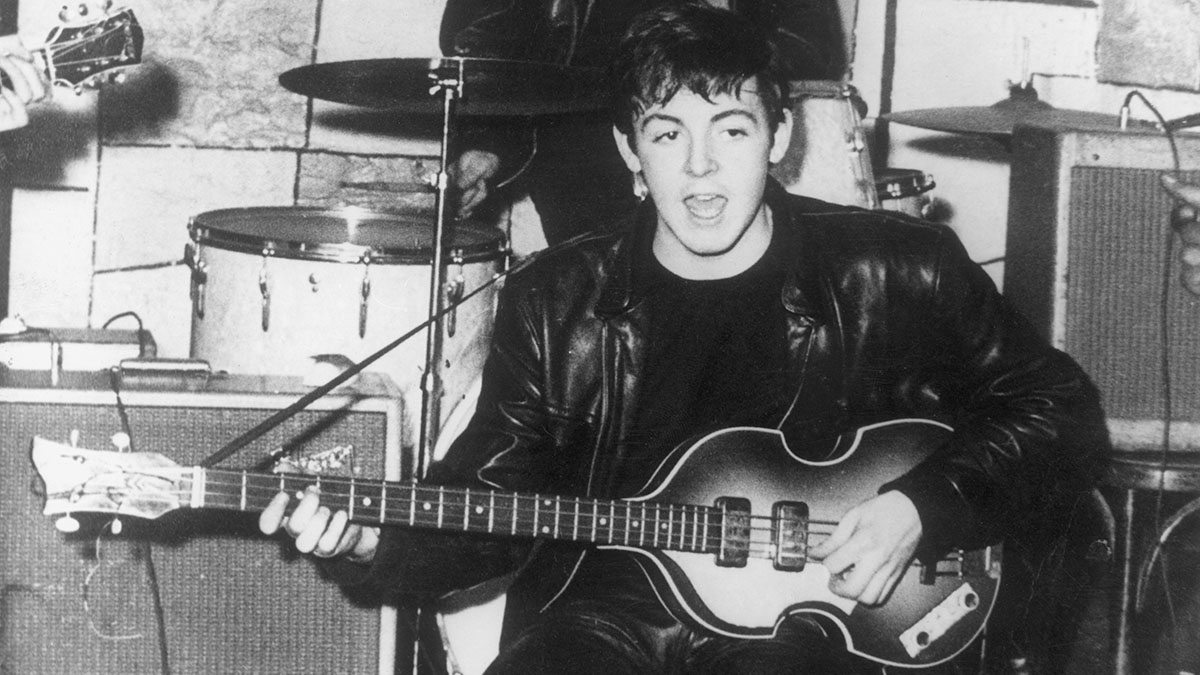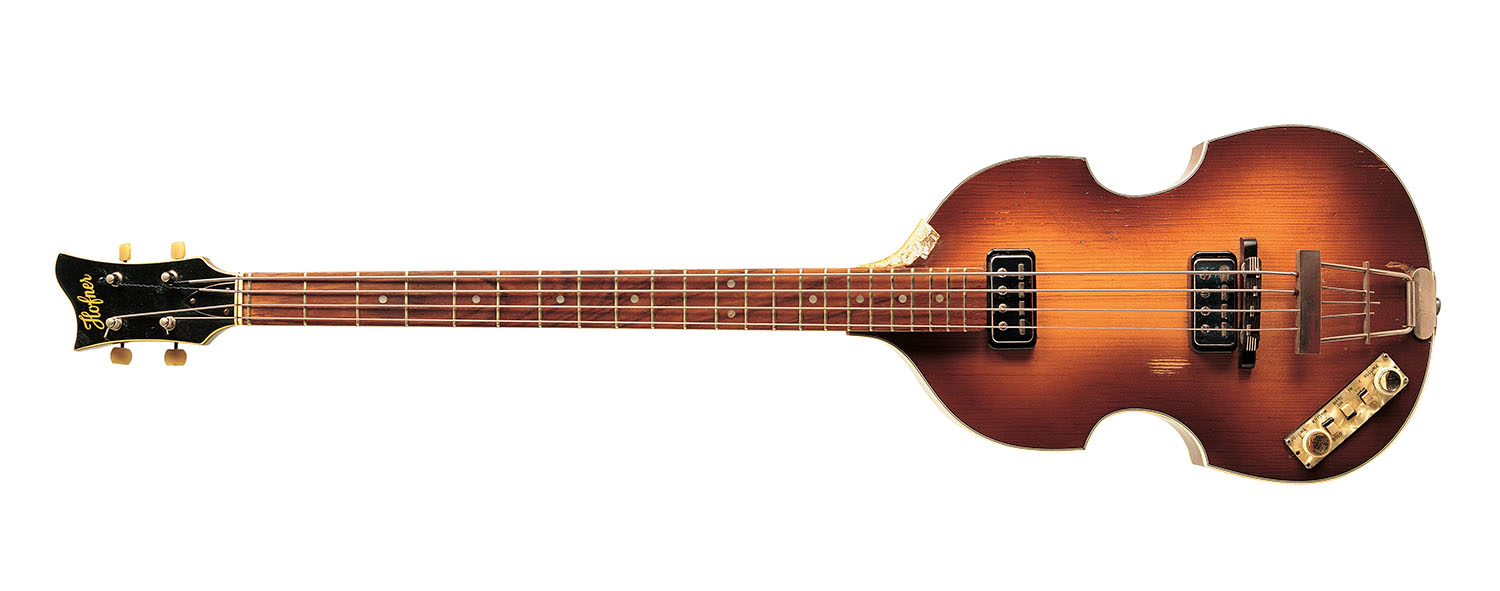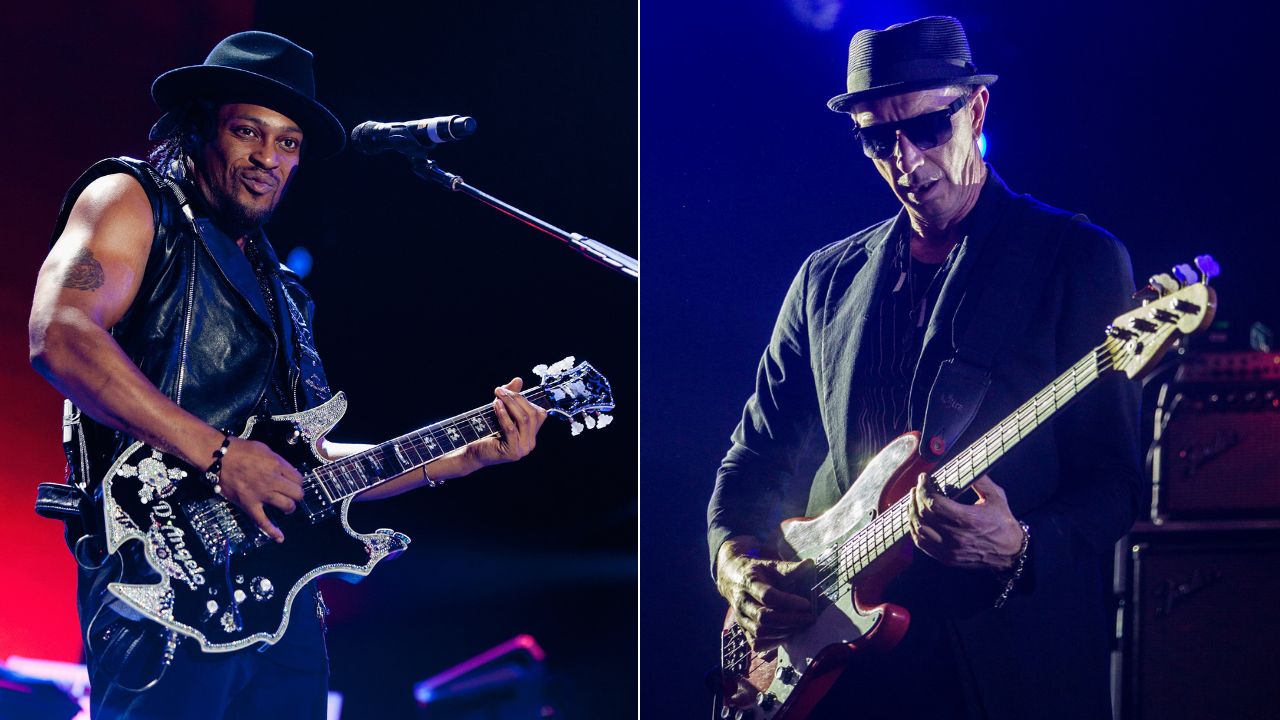
Was there ever been a musician as closely associated with an instrument as Paul McCartney and his Höfner bass? You see a picture of McCartney, and you aren’t at all surprised to see him holding the Höfner... it’s almost as if he was born with it.
All the Beatles have been put under the microscope again and again over the years. This scrutiny has included, on countless occasions, McCartney and his Höfner basses. From this has come numerous legends and myths, many of which are now copied and stated as facts simply because they have been around for years.
For this article, I thought we might try to look at what we know as actual facts, and add to those a little of what we might reasonably suppose to have occurred in the past. I will only include the four Höfner basses that I know McCartney has played in public. He owns several others, but they are in his private collection and as such, I believe it is his business to discuss them, not mine.
The four basses are: the original he purchased in Hamburg in 1961 – the ‘61 bass’; the bass he acquired in the autumn of 1963 – the ‘63 bass’; the ‘Jubilee’ bass given to him by Höfner to play at the Queen’s Jubilee concert in 2012; and the 1967 bass he acquired and used for a private concert in 2016 – the ‘67 bass’.
The ’61 bass
Never has there been so much mystery surrounding a guitar as McCartney’s 1961 Höfner bass. In April 1961, the Beatles returned to Hamburg for a second time to take up a residency at the Top Ten Club from April 1 to July 1. The line-up was John Lennon and George Harrison on guitar, McCartney on piano and guitar, Stuart Sutcliffe on bass, and Pete Best on drums.
Sutcliffe soon announced his intention of leaving, as he wanted to study at the University of Fine Art in Hamburg. The band soon ‘elected’ McCartney to take over the bass. The problem now, for McCartney, was to get his own bass. It is also a problem for us because all the myths, legends, and ideas about what happened next now appear.
What do we know as facts? From interviews given by McCartney and from a statement from the sales assistant in the shop where he purchased his first Höfner, it would appear to be as follows.
All the latest guitar news, interviews, lessons, reviews, deals and more, direct to your inbox!
McCartney took himself off to a large and prestigious music shop, spread over five floors, called Steinway Musikhaus, located at Collonaden 29 in Hamburg, not too far from the Reeperbahn area. Steinway were and still are a premier manufacturer of pianos and, in those days, also had shops. They were a top Höfner dealer, and so knew the product well.

McCartney must have gone up to the fourth floor, as this was where guitars and drums were located. In his own words, he says that he saw a bass guitar with a symmetrical body shape, and thought he might play it upside down and not look stupid. It was also at a price point he could afford.
In an interview for Guitarist magazine in September 1993, he is quoted as saying: “I got my violin bass at the Steinway shop in the town center. I remember going along and there was this bass that was quite cheap...”
Of course, McCartney must have asked the shop assistant, Günter Höper, about buying the bass. During the discussion, Höper realized that McCartney was a left-hander, and so offered to order a left-handed bass. As we know, Steinway was a main dealer for Höfner and would easily have contacted the factory to arrange this.
I want to bury a couple of myths here that have been around for far too long. The idea that McCartney purchased a right-handed bass and converted it to a left-handed bass is false. This simply isn’t possible without putting a whole new top onto the bass.
Another theory is that Steinway had a left-handed bass in stock and so sold him that one. There are no records or evidence that Höfner had ever built a 500/1 bass left-handed before the one for McCartney was ordered. Their catalogs and price list didn’t include one. No photograph of one has ever surfaced, and nobody has ever claimed to have owned one.
How likely is it that Höfner suddenly and speculatively decided to build a left-handed 500/1, that Steinway just happened to take delivery of it, and then McCartney just happened to walk in?
McCartney would now use this bass until October 1963, playing hundreds of gigs and making numerous recordings. The Beatles’ first two albums were recorded with this bass, as were all of their singles up to and including She Loves You. It certainly worked hard!
By the summer of 1963, it was starting to need some repairs, which is not surprising when you consider just how much it had been used, thrown into vans, and generally moved around. The neck pickup frame had broken, and was held together with black tape, a fix made, perhaps, by roadie Mal Evans to keep the bass playing. At some point in the summer of 1963, a replacement bass was ordered and delivered to McCartney in October. The ’61 would then become his backup bass.
In the spring of 1964, the ’61 bass was sent off to Sound City for an overhaul and repairs, although it is not known who decided to do this, nor precisely what they requested should be done.
Whatever, the bass was significantly altered. It was completely resprayed, possibly by Burns, in a three-part dark sunburst poly finish; the two pickups were mounted in a single large (presumably) wooden housing, and the original ‘tea-cup’ knobs were replaced with what seem to be knobs from a radio. Why such drastic action was taken is not known, as all it really required was a general overhaul, the broken pickup frame replaced and a thorough clean.
It would now be used as the backup bass and can be seen in several photographs, propped by the side of the stage, as the Beatles continued to tour. McCartney may have played it live once when a string broke on his ’63 bass, but it is assumed not to have been used on any further recordings until 1968.
It was used by McCartney that year for the film of the song Revolution and is possibly the bass heard on the track on the White Album, though his Rickenbacker 4001 was probably used on the single version.
In January 1969, the Beatles began filming at Twickenham Studios for the Get Back/Let It Be sessions. The ’61 and the ’63 basses are evident in the film, with McCartney using both; however, it is doubtful that the ’61 was used to record the songs that finished up on the Let It Be album. Filming was moved to the basement of Apple HQ in London on January 21st, but the ’61 bass is not seen here.
Some time after the sessions, the ’61 bass disappeared. Over 50 years later, in September 2023, the Lost Bass Project spearheaded a search for the long-lost instrument – and quickly turned up gold.
It was discovered that the instrument was stolen from the back of a van during the night of October 10th 1972, in the Notting Hill area of London.
The bass was ultimately uncovered by an individual living on the south coast of England, who remembered a bass guitar lying in their attic. It finally found its way back to Paul McCartney the same month the search was launched.
Despite 50 years of neglect, the bass was found with its original parts, with only minimal repairs required to make it playable once more. McCartney was said to be “excited as a school boy” to have the bass back in his possession.

The ’63 Bass

At some unknown date in 1963, though probably around June, someone ordered a new 500/1 bass for McCartney. Who did this and how they did it are unknown, and no records survive to tell us. It is likely that Selmer – the UK distributor for Höfner – was asked about it, and they ordered it from the Höfner factory. Selmer was well known then, and had a large shop on the Charing Cross Road in London.
Whatever the circumstances, Höfner produced a left-handed bass, only the second one ever made after the ’61, and sent this over to England. Höfner had uprated the 500/1 model somewhat since McCartney purchased the ’61, so his new bass reflected these changes. The bass now had an arched back, strip tuners, a two-piece neck, and a new headstock logo, and the middle pickup was moved down near to the bridge. It now used type 511 ‘Staple’ humbucking pickups.
McCartney was first seen using his new bass on the British television programme Ready, Steady, Go on October 4 1963, likely the day he received it. For the rehearsal, he used the ’61 bass. He would now use the ’63 bass exclusively for all live, film, and television performances up until the Beatles stopped touring after their final concert at Candlestick Park, San Francisco on August 29, 1966. He would also use it on all records until he got his Rickenbacker 4001 in 1965, which he used for almost all most recordings thereafter.
The ’63 bass was last used with the Beatles for a live performance at the famous rooftop concert on January 30 1969. It was sporting a BASSMAN sticker and had over-long Rotosound strings on it. Following this, it was put away for a long time, only making rare appearances until 1987 when McCartney was recording the Flowers In The Dirt album. Elvis Costello was very involved with the recording of this album, and it was he who suggested McCartney should get the Höfner out again.
McCartney said, ‘[It was] unusual because I had sort of parked it. I had thought I had outgrown it. I started playing it again and never really looked back. It’s great that Elvis encouraged me to take it out.’ After this, he never really used any other bass for live performances and for many recordings. It was, as Costello had remarked, the bass everyone expected to see McCartney with.
Today, McCartney continues to perform and record with the ’63 Höfner, despite some believing it must be an exact copy that they see. I can assure you isn’t, as I’m one of the few people who has done work on this bass. Now nearly 60 years old, it has endured well, with only some routine maintenance and minor repairs. The ’63 bass is known as #1 by McCartney and his crew.
The Jubilee Bass
A concert was organized as part of the celebrations for Queen Elizabeth II’s Diamond Jubilee on July 4, 2012. This was held on a stage at the end of the Mall in front of Buckingham Palace, with McCartney as the headline act.
As a speculative venture, Höfner had two 500/1 basses sprayed in the USA by Kevin Jennings with the Union Jack emblem on the top. The red and blue were sprayed on, but the Union Jack’s white element was represented by the natural wood. The back, sides, and neck were left in the natural wood, and a top coat of clear gloss was applied overall.
The two basses were not built specially for this, but were simply stock basses of the v62 ‘Mersey’ model. Standard parts were then used to finish the basses. All of this was done only a short time before the concert.
One bass was then sent directly to McCartney just days before the concert, as a surprise for him, since Höfner had not told him they were building it. The other bass was kept by Höfner, who still have it, though it has occasionally been loaned out for exhibitions. McCartney began the concert playing his trusty ’63 bass, but for his last song, Ob-La-Di, Ob-La-Da, he switched to the new Jubilee bass. After the concert, he was photographed next to the Queen, holding the Jubilee bass.
The ’67 Bass
On August 30, 2016, at Jimmy Buffett’s house in Sagaponack, Sag Harbor, Hilary Clinton held a ticket-only event as part of her fundraising for the forthcoming Presidential election, for which she was a candidate. The event included performances from Jimmy Buffett, Jon Bon Jovi, and Paul McCartney. Macca’s numbers included Can’t Buy Me Love, Lady Madonna and concluded with Hey Jude.
The problem for McCartney was that he didn’t have a bass guitar with him. Fortunately, his crew were able to locate a left-handed 1967 500/1 for the Clinton event. He liked the bass so much so that he purchased it as a backup bass when touring. It served in this role until 2018, when it was replaced by a unique handmade 500/1, built explicitly as the backup. McCartney retains the ’67 bass in his collection. It has recently been away for an overhaul and a neck reset.
It’s tough to write an article like this and not leave out many facts and figures, especially when writing about the most famous musician in the world. I haven’t dwelled very much on each bass’s technical details, simply because much of this information is already out there on the internet. The magic is simply McCartney and his little Höfner, not what plectrum he uses or the strings that are fitted. This guy could have any bass in the world – but he opts to play the ‘cheap’ one he has had since 1963.
- With thanks to Chris Dekker, Clement Cachot-Coulom, Keith Smith, and Klaus Voormann.
